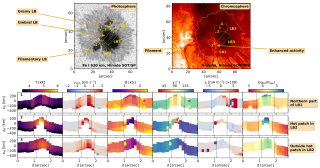El descubrimiento de que las galaxias mas masivas eran mucho mas compactas en el pasado que las galaxias que tienen igual masa hoy, representa uno de los mayores retos para los escenarios actuales que describen la formacion de las galaxias. Una de las ideas que se han sugerido es que estas galaxias compactas se han ido transformado con el tiempo en los núcleos de las galaxias mas masivas que vemos hoy en dia. Nuestro grupo ha llevado a cabo dos estudios paralelos para por un lado tratar de identificar galaxias masivas y compactas que pudieran haber sobrevivido intactas desde su formación inicial y por lo tanto estudiar sus propiedades y otro estudio para explorar la evolución estructural y dinámica de estos objetos a medida que el tiempo transcurre. Hemos encontrado que hoy en dia la poblacion de galaxias masivas y compactas es extremadamente pequeña (<0.03% de las galaxias masivas) y sorprendentemente son objetos relativamente jovenes. Estos resultados sugieren que las galaxias mas masivas se forman siempre de manera compacta y luego evolucionan hasta formar la poblacion actual. Ademas, este analisis nos indica que la evolucion de estos objetos compactos y lejanos debe ser muy rapida pues ya no es posible encontrar ninguno de estas galaxias en la actualidad. Por otro lado, nuestro análisis de la evolución dinamica de los objetos mas masivos es compatible con un escenario donde el halo de materia oscura ya estaba formado en el pasado y el enorme crecimiento observado en tamaño de estos objetos solo se ha producido en la distribución de sus estrellas. En conjunto, nuestros resultados parecen indicar que estas galaxias masivas se formaron en un estallido muy intenso de formación estelar y luego han evolucionado hasta convertirse en el nucleo de las galaxias mas masivas del universo cercano a traves de la acrecion de otras galaxias satelites mas pequeñas.
Advertised on
References
Trujillo, I. et al. (2009). ApJL 692, 118
It may interest you
-
 It’s been decades since the need to study other stars to understand the past, present and future of the Sun was realized. One important aspect that has been investigated is the magnetic activity of stars for which we cannot fully grasp the mechanisms involved. Indeed, the origin of stellar magnetic cycles or the dependence of the magnetic activity on the stellar properties are not completely understood. This knowledge improves not only our understanding of the physics involved in stellar evolution but also affects the study of the Sun to better predict high-energy events and the betterAdvertised on
It’s been decades since the need to study other stars to understand the past, present and future of the Sun was realized. One important aspect that has been investigated is the magnetic activity of stars for which we cannot fully grasp the mechanisms involved. Indeed, the origin of stellar magnetic cycles or the dependence of the magnetic activity on the stellar properties are not completely understood. This knowledge improves not only our understanding of the physics involved in stellar evolution but also affects the study of the Sun to better predict high-energy events and the betterAdvertised on -
 Light bridges are elongated and bright structures protruding into the umbra of sunspots. The presence of light bridges has a significant role in the evolution of sunspots and the heating of their overlying atmosphere. Therefore, investigating these structures is crucial to understanding fundamental aspects of sunspots. By applying a novel code based on deep-learning algorithms called SICON to spectropolarimetric observations acquired with the Hinode satellite, we computed atmospheric parameters that allowed us to infer the variation of the physical properties of light bridges on a geometricAdvertised on
Light bridges are elongated and bright structures protruding into the umbra of sunspots. The presence of light bridges has a significant role in the evolution of sunspots and the heating of their overlying atmosphere. Therefore, investigating these structures is crucial to understanding fundamental aspects of sunspots. By applying a novel code based on deep-learning algorithms called SICON to spectropolarimetric observations acquired with the Hinode satellite, we computed atmospheric parameters that allowed us to infer the variation of the physical properties of light bridges on a geometricAdvertised on -
 The formation and evolution of the disk of our Galaxy, the Milky Way, remains an enigma in astronomy. In particular, the relationship between the thick disk and the thin disk —two key components of the Milky Way— is still unclear. Understanding the chemical and dynamical properties of the stars within these disks is crucial, especially in the parameter spaces where their characteristics overlap, such the metallicity regime around [Fe/H] ~ -0.7, which marks the metal-poor end of the thin disk, higher than that of the thick disk. This is often interpreted as an indication that the thin diskAdvertised on
The formation and evolution of the disk of our Galaxy, the Milky Way, remains an enigma in astronomy. In particular, the relationship between the thick disk and the thin disk —two key components of the Milky Way— is still unclear. Understanding the chemical and dynamical properties of the stars within these disks is crucial, especially in the parameter spaces where their characteristics overlap, such the metallicity regime around [Fe/H] ~ -0.7, which marks the metal-poor end of the thin disk, higher than that of the thick disk. This is often interpreted as an indication that the thin diskAdvertised on
